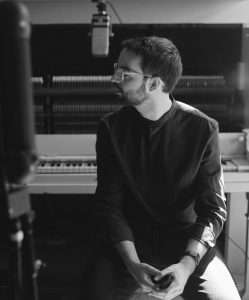 Songwriter and producer Connor Seidel – who’s worked with Charlotte Cardin, Matt Holubowski, and David Lafleche, among others] – invited a dozen of Québec’s best musicians to the Tree House studio in St-Adèle to embark on the ambitious 1969 project, a refreshing evocation of the naïveté and sweetness of the era’s folk records.
Songwriter and producer Connor Seidel – who’s worked with Charlotte Cardin, Matt Holubowski, and David Lafleche, among others] – invited a dozen of Québec’s best musicians to the Tree House studio in St-Adèle to embark on the ambitious 1969 project, a refreshing evocation of the naïveté and sweetness of the era’s folk records.
“To me, Joni Mitchell’s Clouds and Nick Drake’s Five Leaves Left are the anchor points of this project. It’s very soft and genteel music. Ultimately, it’s storytelling for the silent generation,” says Seidel.
1969, erotic year, as Serge Gainsbourg put it. Yet, there was also Woodstock, the Vietnam War, protest movements of all kinds – this period of social unrest also gave us music that was much more politically charged.
“Initially, I wanted to use classical guitar on all the songs, with string arrangements and flutes, to fully incorporate these elements and echo the way this music was anchored in ethereal melodies,” says Seidel. “1969 is not a pastiche, it’s much more a state of mind. We didn’t compress the sound, it’s raw; we even used the same ribbon mic for all the voices.”.
Each song is the subject of a short video where the musicians share their thoughts. This is what Jason Bajada says about his collaboration: “Connor and I fell in love with a Neil Diamond album from 1969 (Touching You, Touching Me). I love artists that are able to walk the cheesy line, to dip their toes in and it’s all good.”
“Live recordings are a feature of the records of the time, and it made my job so much easier,” says Seidel. “Musicians don’t feel the pressure of trying to be perfect in such a relaxed context. We threw open the windows and doors of the studio when it started getting really hot. Louis-Jean [Cormier] went out on the terrace to record his song (“Même les Loups versent des larmes de joie”) and the sound of cicadas and insects can be clearly heard in the background. Ariane [Moffat] climbed on the roof for her recording: nature sounds are part of the process. And with Ariane, it’s special, because when she got to the studio, she composed a melody on the piano that immediately gave its meaning to the song, and we recorded it in a single take.”
About the Treehouse studio, located in Sainte-Adèle, Seidel says, “I’ve worked there for almost four years now, it’s my creative grotto. With the help of Ghyslain-Luc Lavigne, who co-produced the project with me, I was confident that the live sessions would be properly recorded.”
A project of this scope, with such a stellar cast, could take months to see through, a luxury Seidel didn’t have. Each artist showed up with their lyrics and melody. Everything recording needed to be wrapped up in a single day.
Elisapie, Safia Nolin, Half Moon Run, Antoine Gratton (who penned all the string arrangements), Matt Holubowski, Les sœurs Boulay, Elliot Maginot, and Claudia Bouvette are also part of the assembled collective. “Claudia’s pop music, which I’ve worked on, is at the opposite end of the 1969 mindset,” says Seidel. “I also love it when she sings with just a guitar or a ukulele. We wrote “Post Mortem” with a super-dramatic harp and voice a capella arrangement! It turned out to be one of my favourite songs on the album.”
Philippe Brault and Joseph Mihalcean delicately handle three short, luminous instrumentals that they create themselves, and that divinely slip into the continuous flow of the album. “I wanted to get out of the normal framework of a song, and add long cinematic interludes,” says Seidel. “These two have done amazing work in the realm of movie soundtracks.”
Bajada best summarized the atmosphere of these sessions: “Connor loved the idea of watching two individuals just waltzing, dancing together, thinking they’re alone in the world, but there’s someone in the other room watching them and hoping the moment drags on. Except in the end, everyone goes home.”
1969 is an album that sits outside of time, and outside of today’s production standards. The completion of such a project is in itself remarkable, and the pandemic was worth such a well-executed look in the mirror.